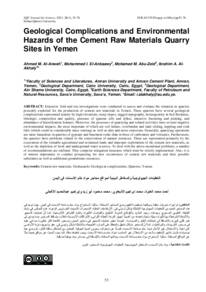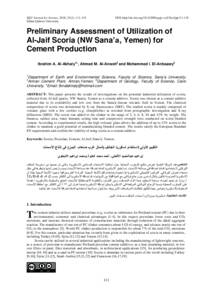وثيقة
Geological complications and environmental hazards of the cement raw materials quarry sites in Yemen.
المعرف
https://doi.org/10.53539/squjs.vol28iss1pp53-76
المصدر
Sultan Qaboos University Journal for Scientific. Vol. 28, no.1, p.53-76.
المساهمون
الدولة
Oman.
مكان النشر
Muscat
الناشر
College of Science, Sultan Qaboos University.
ميلادي
2023-01-01
اللغة
الأنجليزية
الموضوع
الملخص الإنجليزي
Extensive field and site investigations were conducted to assess and evaluate the situation in the presently exploited quarries of cement raw materials in Yemen. These quarries have several geological complications represented mainly by high elevations, steep slopes, rugged topography, heterogeneity in bed thickness, lithologic composition and quality, presence of igneous sills and dykes, intensive fracturing and jointing and abundance of karstification features. Moreover, the processes of quarrying and related operations have several negative environmental impacts the most important of which are soil failure, overburden and land sliding, toppling and rock falls (which result in considerable mass wasting) and emission of dust and noise. Generally, quarrying operations are more hazardous in quarries of gypsum and basement rocks than in those of carbonates and volcanics. Furthermore, the quarries have problems related to the conservation of natural resources. These are represented primarily by the excavation of the valuable agricultural and reclaimed lands and improper exploitation of the cement raw materials and the fresh and underground waters the reserves of which decreased drastically. To deal with the above-mentioned problems, a number of recommendations are outlined. They comprise mitigation measures which must be strictly implemented. Also, it is of almost importance to conduct prospecting for new occurrences of the presently exploited cement raw materials and their possible substitutes as well as additional groundwater resources.
ISSN
2414-536X
الملخص العربي
تم اجراء تحريات حقلية وموقعية مستفيضة لتقييم وضع المحاجر المستغلة-حاليًا-لاستخراج مواد خام صناعة الاسمنت في اليمن.حيث توجد في هذه المحاجرالعديد من التعقيدات الجيولوجيةالمتمثلة بشكل أساسي في :الارتفاعات العالية، المنحدرات الشديدة، التضاريس الوعرة، عدم التجانس فس سمك الطبقة،التكوين الصخري وجودته، وجود السدود والقواطع النارية،الشقوق والفواصل الكثيرة، وكثرة الظواهر الكارستيىة. كما أن َّ لعمليات التحجير والأنشطة المرتبطة بها تأثيرات بيئيّة سلبية متعددة؛ من أهمها:انهيار التربة، الغطاء الترابي، الانزلاقات الأرضية، انقلاب وتساقط الصخور (مما يؤدي إلى هدر كتلي كبير)، بالإضافة إلى انبعاثاتالغبار والضوضاء. عمومًا، تعتبر عمليات التحجير في محاجر الجبس وصخور القاعدة أكثر خطورة مما هي عليه
في صخور الكربونات والبركانيات. كما أن َّ للمحاجر مشاكل تتعلق بالحفاظ على الموارد الطبيعية؛ والمتمثلةبشكلرئيسي في:حفر وتجريف تربةالأراضي
الزراعية،والاستغلال غيرالأمثللمواد خامصناعةعن ا ً الاسمنت، فضلاستنزاف مخزون المياهالجوفية. للتعامل مع المشاكل سالفة الذّكر، تم ّ وضع عدة توصيات؛تشمل تدابير للتخفيف والحد من الاستغلال غير المناسب لمواد خام صناعة الاسمنت ويجب تنفيذها بدقة.كمايجب البحث عن مواقع جديدة بدلا عن المواقع المستغلة-حاليًا-لاستخراج مواد خام صناعة الاسمنت وبدائلها الممكنة،بالإضافة إلى مصادر مياه جوفية اضافية
في صخور الكربونات والبركانيات. كما أن َّ للمحاجر مشاكل تتعلق بالحفاظ على الموارد الطبيعية؛ والمتمثلةبشكلرئيسي في:حفر وتجريف تربةالأراضي
الزراعية،والاستغلال غيرالأمثللمواد خامصناعةعن ا ً الاسمنت، فضلاستنزاف مخزون المياهالجوفية. للتعامل مع المشاكل سالفة الذّكر، تم ّ وضع عدة توصيات؛تشمل تدابير للتخفيف والحد من الاستغلال غير المناسب لمواد خام صناعة الاسمنت ويجب تنفيذها بدقة.كمايجب البحث عن مواقع جديدة بدلا عن المواقع المستغلة-حاليًا-لاستخراج مواد خام صناعة الاسمنت وبدائلها الممكنة،بالإضافة إلى مصادر مياه جوفية اضافية
قالب العنصر
مقالات الدوريات


